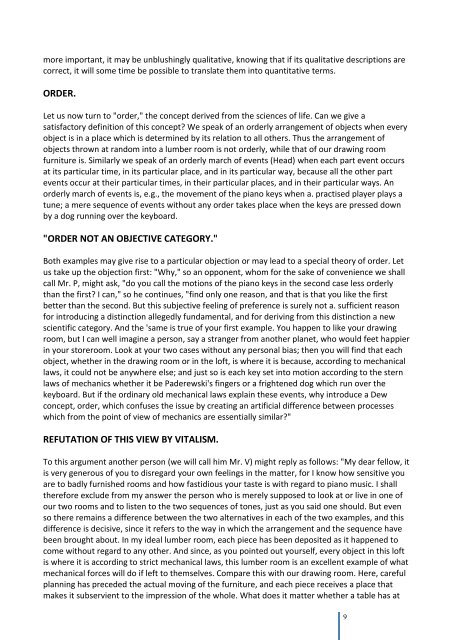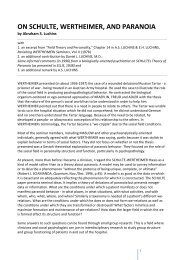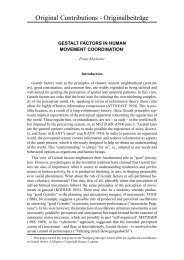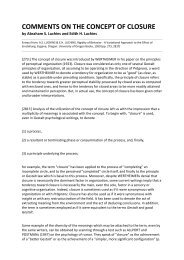Principles of Gestalt Psychology - Society for Gestalt Theory and its ...
Principles of Gestalt Psychology - Society for Gestalt Theory and its ...
Principles of Gestalt Psychology - Society for Gestalt Theory and its ...
You also want an ePaper? Increase the reach of your titles
YUMPU automatically turns print PDFs into web optimized ePapers that Google loves.
more important, it may be unblushingly qualitative, knowing that if <strong>its</strong> qualitative descriptions arecorrect, it will some time be possible to translate them into quantitative terms.ORDER.Let us now turn to "order," the concept derived from the sciences <strong>of</strong> life. Can we give asatisfactory definition <strong>of</strong> this concept? We speak <strong>of</strong> an orderly arrangement <strong>of</strong> objects when everyobject is in a place which is determined by <strong>its</strong> relation to all others. Thus the arrangement <strong>of</strong>objects thrown at r<strong>and</strong>om into a lumber room is not orderly, while that <strong>of</strong> our drawing roomfurniture is. Similarly we speak <strong>of</strong> an orderly march <strong>of</strong> events (Head) when each part event occursat <strong>its</strong> particular time, in <strong>its</strong> particular place, <strong>and</strong> in <strong>its</strong> particular way, because all the other partevents occur at their particular times, in their particular places, <strong>and</strong> in their particular ways. Anorderly march <strong>of</strong> events is, e.g., the movement <strong>of</strong> the piano keys when a. practised player plays atune; a mere sequence <strong>of</strong> events without any order takes place when the keys are pressed downby a dog running over the keyboard."ORDER NOT AN OBJECTIVE CATEGORY."Both examples may give rise to a particular objection or may lead to a special theory <strong>of</strong> order. Letus take up the objection first: "Why," so an opponent, whom <strong>for</strong> the sake <strong>of</strong> convenience we shallcall Mr. P, might ask, "do you call the motions <strong>of</strong> the piano keys in the second case less orderlythan the first? I can," so he continues, "find only one reason, <strong>and</strong> that is that you like the firstbetter than the second. But this subjective feeling <strong>of</strong> preference is surely not a. sufficient reason<strong>for</strong> introducing a distinction allegedly fundamental, <strong>and</strong> <strong>for</strong> deriving from this distinction a newscientific category. And the 'same is true <strong>of</strong> your first example. You happen to like your drawingroom, but I can well imagine a person, say a stranger from another planet, who would feet happierin your storeroom. Look at your two cases without any personal bias; then you will find that eachobject, whether in the drawing room or in the l<strong>of</strong>t, is where it is because, according to mechanicallaws, it could not be anywhere else; <strong>and</strong> just so is each key set into motion according to the sternlaws <strong>of</strong> mechanics whether it be Paderewski's fingers or a frightened dog which run over thekeyboard. But if the ordinary old mechanical laws explain these events, why introduce a Dewconcept, order, which confuses the issue by creating an artificial difference between processeswhich from the point <strong>of</strong> view <strong>of</strong> mechanics are essentially similar?"REFUTATION OF THIS VIEW BY VITALISM.To this argument another person (we will call him Mr. V) might reply as follows: "My dear fellow, itis very generous <strong>of</strong> you to disregard your own feelings in the matter, <strong>for</strong> I know how sensitive youare to badly furnished rooms <strong>and</strong> how fastidious your taste is with regard to piano music. I shallthere<strong>for</strong>e exclude from my answer the person who is merely supposed to look at or live in one <strong>of</strong>our two rooms <strong>and</strong> to listen to the two sequences <strong>of</strong> tones, just as you said one should. But evenso there remains a difference between the two alternatives in each <strong>of</strong> the two examples, <strong>and</strong> thisdifference is decisive, since it refers to the way in which the arrangement <strong>and</strong> the sequence havebeen brought about. In my ideal lumber room, each piece has been deposited as it happened tocome without regard to any other. And since, as you pointed out yourself, every object in this l<strong>of</strong>tis where it is according to strict mechanical laws, this lumber room is an excellent example <strong>of</strong> whatmechanical <strong>for</strong>ces will do if left to themselves. Compare this with our drawing room. Here, carefulplanning has preceded the actual moving <strong>of</strong> the furniture, <strong>and</strong> each piece receives a place thatmakes it subservient to the impression <strong>of</strong> the whole. What does it matter whether a table has at9
















